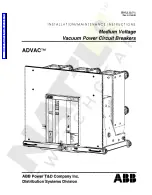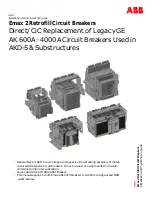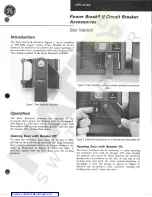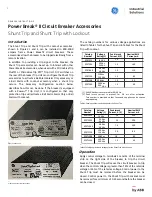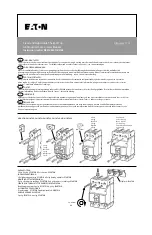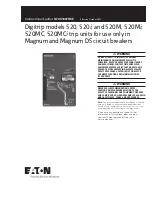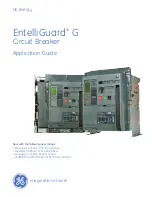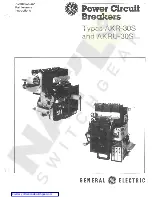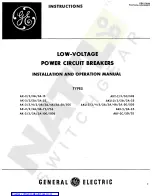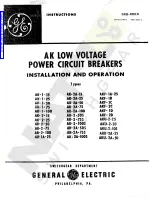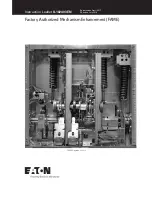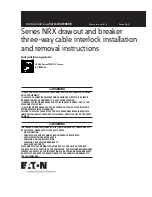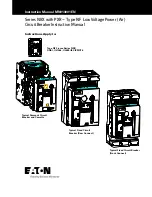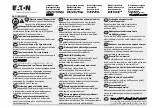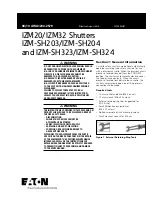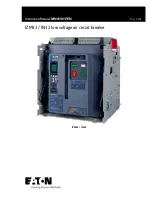
IB 6.2.11.1-1C
Page 6
ABB
normally closed (N.C.), with either common or isolated
return circuits. The Trip Lockout prevents circuit
breaker reclosure when the automatic trip indicator is in
the extended position. To reset the automatic trip
indicator, and when so equipped the R/S switch and/or
Trip Lockout, simply push the white indicator in toward
the front escutcheon; it will relatch automatically
(except for breakers with Undervoltage Trip Device -
see discussion later in this bulletin).
It is very important that the operator investigate the
cause of the overcurrent trip prior to resetting the
automatic trip indicator and reclosing the circuit
breaker.
The indicator will also extend when the circuit breaker
is tripped by the optional Under-Voltage Device, or by
the Open Fuse Trip device on fused breakers.
(Note: The circuit breaker can be reclosed without
resetting the automatic trip indicator when the circuit
breaker is not equipped with the optional Trip Lockout.)
Motor Disconnect Switch
- On electrically operated
(EO) circuit breakers, a switch is provided when the
operator wants to prevent recharging of the closing
springs, as when the circuit breaker is racked in or out.
It can also be used to disconnect the motor from the
control wiring when performing control wiring dielectric
tests.
Maintenance Handle
- This accessory must be
installed underneath the circuit breaker to manually
charge the springs of an electrically operated (EO)
circuit breaker.
Padlocking Device
- All K-Line Plus circuit breakers
are provided with a padlock hasp to lock the circuit
breaker in a trip-free condition which prevents circuit
breaker closing. To engage this device, simply push in
the manual trip push button then pull straight out on the
padlock hasp. This hasp can accommodate up to three
padlocks. When padlocking is engaged the circuit
breaker cannot be racked to any other position.
Manual Trip Button
- All K-Line Plus models feature a
manual trip push button for tripping the circuit breaker.
Open/Close Indicator
- All K-Line Plus circuit breakers
have a visual indicator showing the status of the circuit
breaker contacts. OPEN appears in silver with a green
background, CLOSED appears in silver with a red
background.
Racking Shutter and Racking Mechanism
- The
racking shutter of all K-Line Plus circuit breakers allows
access to the racking shaft when lifted. The circuit
breaker must be tripped before the shutter can be lifted
This prevents racking the circuit breaker with the main
contacts closed.
The padlock hasp holds the racking shutter closed
when the hasp is activated. Instructions appear on the
side of the front escutcheon of the circuit breaker for
racking the breaker into and out of its cubicle. Circuit
breaker racking is possible with the cubicle door open
or closed. Indicators on the cubicle indicate the position
of the circuit breaker during racking.
Closing Spring Charge Indicator
- On electrically
operated (EO) models, the closing spring charge
indicator shows through a window in the front
escutcheon. A yellow indicator with black lettering
indicates SPRINGS CHARGED; one with white
background and black lettering indicates SPRINGS
DISCHARGED. When the Motor Disconnect Switch is
ON and control power is available, the springs will
automatically charge after any breaker trip operation.
Operation Counter
(not shown) - The non-resetable
operation counter advances one count each time the
circuit breaker is closed. The counter on new circuit
breakers may show counts of 9950 or greater so that
the counter will advance to 0000 during check-out prior
to energization. Circuit breaker operation record
keeping can thus begin from the 0000 point.
Self-aligning Dust Plate
- The dust plate immediately
behind the escutcheon face plate is used to exclude
dust from the circuit breaker compartment. The
escutcheon face will protrude through the front door of
the compartment when the circuit breaker is in the
"TEST” and "DISCONNECTED" positions. In these
positions, the dust plate still functions to exclude dust.
Local Electrical Close and Trip Push Buttons
(optional)
- On electrically operated (EO) models these
push buttons may be ordered as an option. These
switches energize the circuit breaker close/trip coils
when the circuit breaker is in the "TEST and/or
"CONNECTED” position. On manually operated (MO)
breakers with a shunt trip, only the trip push button is
provided when this option is ordered.
CIRCUIT BREAKER INTERNAL COMPONENTS
For electrically operated (EO) circuit breakers, the
schematic diagram of the control circuit in the
Operating Sequence section illustrates the function of
the following devices. Electrical characteristics can be
found in Figure 2.
Solid State Control Device (SSCD)
- The SSCD is






















